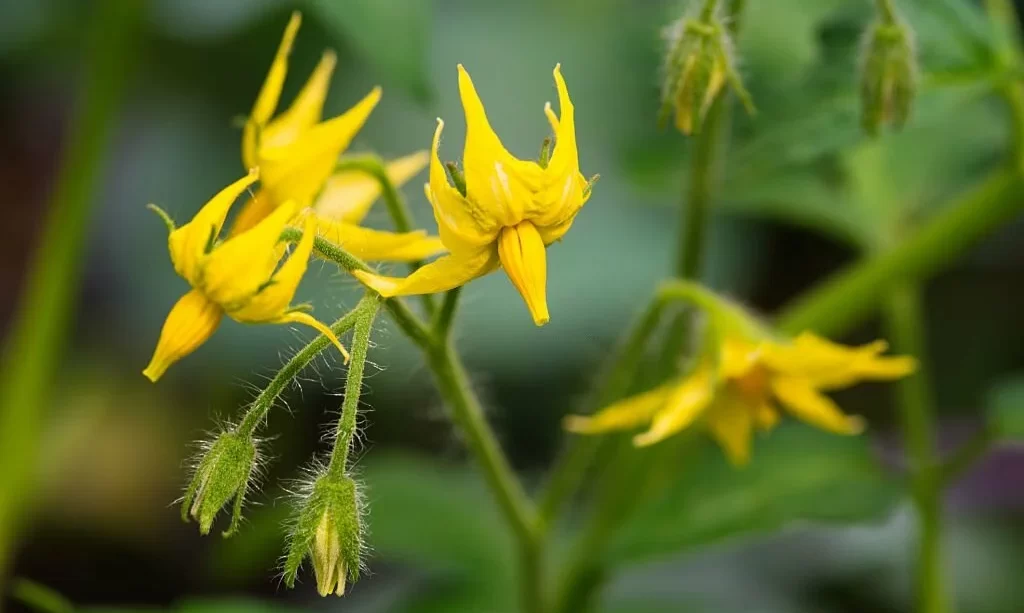Tomatoes are a staple in many gardens and kitchens, prized for their juicy, flavorful fruits. To enjoy a bountiful harvest of these delectable red gems, encouraging robust flowering in your tomato plants is key. This article delves into the art and science of increasing flowering in tomatoes, offering insights and strategies to help you achieve a thriving tomato crop. From understanding the plant’s physiology to selecting the right varieties, we will guide you on a journey to maximize the number of flowers and, ultimately, the fruits that grace your garden.
- Burpee Organic All Purpose Granular Plant Food is formulated for long-lasting results
- The easy-to-apply granules release essential nutrients immediately and continue to provide a continuous stream of plant food for up to 3 months
- Contains nutrients, plants will produce superior results throughout the season
- Omri listed for organic use
- Since 1876: Generations of customers have trusted Burpee to deliver the highest quality products and service. Gardeners rely on Burpee for accurate plant information and how-to tips that make gardening easier and more successful. Let’s grow together!
Tomato Plant Physiology
To increase flowering in tomatoes, it’s essential to grasp the plant’s physiology and how it relates to the flowering process:
- Growth Stages: Tomato plants go through distinct growth stages, including germination, vegetative growth, flowering, and fruiting. Understanding these stages helps in timing and managing flowering.
- Factors Influencing Flowering: Several factors, including temperature, light, and nutrition, influence when and how abundantly tomato plants flower. Balancing these factors is crucial for successful flowering.
- Flowering and Fruit Set: It’s vital to know that the flowers of tomato plants are responsible for fruit development. Healthy and abundant flowering directly impacts your tomato harvest.
Selecting the Right Tomato Varieties
Selecting the right tomato varieties plays a significant role in achieving optimal flowering and fruit production:
- Growing Conditions: Consider your local climate and growing conditions. Some tomato varieties are better suited to specific climates, such as heat-tolerant varieties for warmer regions or cold-tolerant ones for cooler areas.
- Determinate vs. Indeterminate: Determine whether you want determinate or indeterminate tomato varieties. Determinate tomatoes tend to produce a concentrated set of fruit and are often more suitable for container gardening. Indeterminate varieties continually produce fruit throughout the growing season.
- Flowering Characteristics: Research the flowering habits of different tomato varieties. Some varieties naturally produce more flowers, while others are known for their fruit-bearing efficiency. Choose varieties that align with your goals for flowering and fruiting.
Selecting the right tomato varieties tailored to your growing conditions and goals is the first step in encouraging a flourishing tomato garden. By understanding the plant’s physiology and the critical role of flowering, you’ll be better equipped to apply the following strategies to maximize your tomato yields.
Optimal Growing Conditions for Tomatoes
Creating the right growing conditions for your tomato plants is vital for encouraging abundant flowering:
- Temperature: Tomatoes thrive in warm temperatures, typically between 70-85°F (21-29°C). Ensure your tomato plants are exposed to these ideal temperature ranges, as cooler temperatures can slow down flowering and fruit development.
- Sunlight: Tomatoes are sun-loving plants. They require a minimum of 6-8 hours of direct sunlight each day. Ensure they have access to adequate sunlight to fuel photosynthesis and support flowering.
- Soil Preparation: Prepare well-draining soil with a slightly acidic pH of around 6.0-6.8. Amending the soil with organic matter can improve nutrient retention and promote root health.
- Made with premium ingredients
- Contains compost, peat moss, aged bark and lime
- Great for improving and revitalizing the soil in and around your vegetable garden beds
- Naturally lightweight and contains just the right ingredients to grow plentiful, flavorful tomatoes and vegetables
- 20-quart bag
Pruning and Supporting Tomato Plants
Pruning and providing support for your tomato plants can significantly enhance flowering:
- Pruning: Regularly prune your tomato plants by removing suckers (the small shoots that develop in the leaf axils). Pruning allows the plant to focus its energy on flowering and fruit production, rather than excessive foliage growth.
- Support Systems: Implement staking, caging, or trellising methods to support your tomato plants. Keeping the plants off the ground not only helps protect the fruit but also ensures better air circulation and light exposure, which are crucial for flowering.
Proper Watering and Fertilization
Watering and providing the right nutrients are essential components of flowering success for your tomato plants:
- Watering: Maintain consistent soil moisture by watering your tomato plants evenly. Avoid letting the soil become overly dry between watering, as this can lead to flower drop. A soaker hose or drip irrigation can help deliver water directly to the root zone.
- Fertilization: Use a balanced fertilizer formulated for tomatoes. Fertilize your plants early in the season and then provide supplemental nutrients as they grow. Too much nitrogen can lead to lush foliage at the expense of flowering, so follow recommended guidelines.
By creating optimal growing conditions, implementing proper pruning and support, and ensuring your tomato plants receive the right amount of water and nutrients, you’ll set the stage for increased flowering and a more abundant tomato harvest. These practices help your plants thrive and channel their energy into producing an abundance of beautiful flowers, which will eventually transform into delicious, homegrown tomatoes.
- FOR USE ON: Use Tomato-tone organic fertilizer for all types of tomatoes; both heirloom and hybrid. It Produces plump, abundant tomatoes, not unwanted foliage. Can also be used on all vegetables.
- CONTAINS: Tomato-tone is a rich blend of the finest natural & organic ingredients enhanced with our exclusive Bio-tone formula; 3-4-6 Fertilizer analysis with 8% calcium to help prevent blossom end rot. Tomato-tone is environmentally Safe – No sludges or toxic ingredients.
- WHEN / HOW TO USE: Best to use Tomato-tone fertilizer every two weeks through the growing season. Apply to the soil around the drip line of the plant and then water thoroughly. Tomato-tone is ready to use and requires no mixing.
- FOR ORGANIC GARDENING: Tomato-tone is approved for organic gardening; It is a registered Organic Input Material meaning it meets all requirements for organic production.
- MADE IN THE USA: Product of the Espoma Company. The leader in natural organics since 1929
Pollination Strategies
Understanding and implementing effective pollination strategies can significantly impact your tomato plant’s flowering and fruit production:
- Hand Pollination: In cases of poor pollinator activity, you can use a soft brush or your fingers to gently transfer pollen between flowers. This ensures adequate pollination, particularly for indoor or greenhouse-grown tomatoes.
- Attract Beneficial Insects: Encourage the presence of pollinators like bees by planting flowers that attract them near your tomato garden. A diverse garden can create a welcoming environment for these valuable helpers.
- Shake the Stakes: Give your staked tomato plants a gentle shake when they are in full bloom. This simulates the breeze and helps release pollen, facilitating self-pollination.
Pest and Disease Management
To maintain a healthy tomato garden with prolific flowering, effective pest and disease management is crucial:
- Pest Prevention: Regularly inspect your plants for common pests such as aphids, whiteflies, and hornworms. Early detection and control methods, including neem oil or insecticidal soap, can prevent infestations.
- Disease Monitoring: Keep an eye out for diseases like early blight and powdery mildew, which can hinder flowering. Maintain good air circulation and consider copper-based fungicides when necessary.
Time-Tested Tips for More Flowers
Experienced gardeners have shared valuable tips to increase flowering in tomato plants:
- Companion Planting: Plant companion flowers such as marigolds, nasturtiums, and basil near your tomatoes. These companion plants can attract beneficial insects and deter pests.
- Epsom Salt Solution: Some gardeners swear by an occasional Epsom salt solution applied to the soil. The magnesium in Epsom salt can potentially enhance flowering and fruiting.
- Selective Pruning: Focus on pruning to remove lower leaves, which allows more sunlight to reach the upper parts of the plant where flowering occurs.
- Pure Original Ingredients Epsom Salt is pure magnesium sulfate
- Use as a soaking solution, coarse cleaner & exfoliant
- Add to DIY bath bombs & more
- Always pure ingredients with no additives
- Convenient bulk size
Conclusion
Encouraging abundant flowering in your tomato garden is an art that requires knowledge, dedication, and a deep appreciation for the beauty of nature’s processes. By understanding the physiology of tomato plants, selecting suitable varieties, and creating the optimal growing conditions, you lay a strong foundation for a flourishing tomato crop.
Remember that each flower represents the promise of a delicious, homegrown tomato. By implementing pollination strategies, managing pests and diseases, and adopting time-tested gardening tips, you can transform that promise into a reality. Your tomato plants will reward your care and attention with vibrant blooms that pave the way for a plentiful harvest, ensuring that your garden is graced with the glorious sight of ripe, red, and delectable tomatoes.







